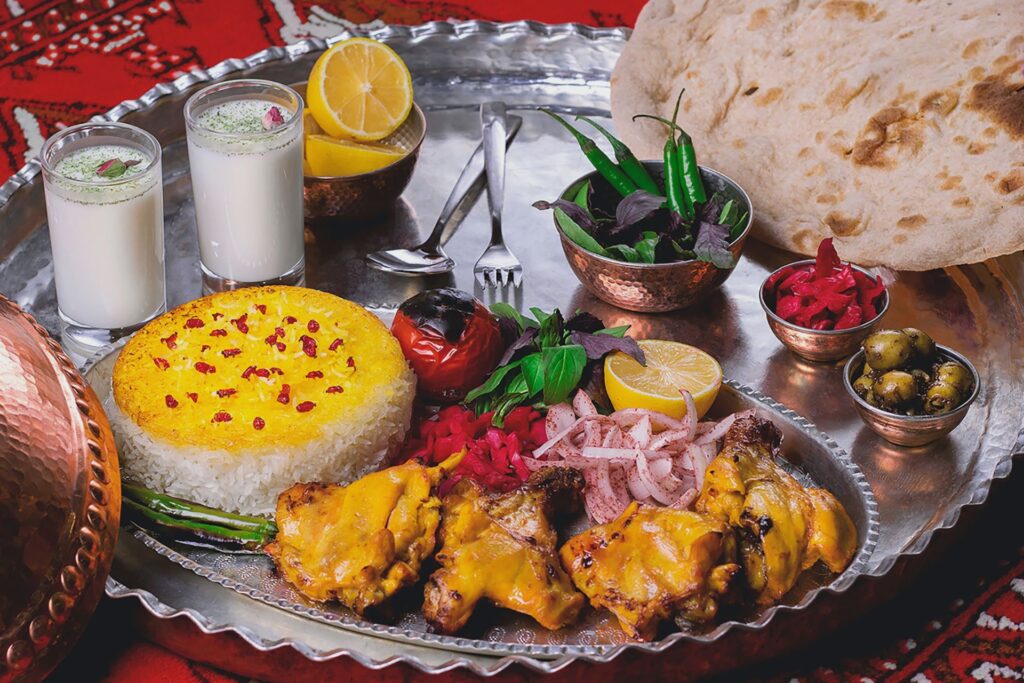Yearning to celebrate Nowruz with the most delicious and authentic dishes? You’re not alone. Nowruz, the Persian New Year, is a unique celebration marked by traditional Iranian flavors that welcome spring and the start of a new year.
This article is your all-in-one guide – from preparing mouthwatering main courses to sweet desserts – for an unforgettable Nowruz feast! Dig in – there’s a world of flavors waiting for you!
Table of Contents
Key Takeaways
- Nowruz, the Persian New Year, is a celebration that features traditional Iranian flavors and dishes.
- Some of the delicious and authentic Nowruz dishes include Sabzi Polo ba Mahi (Herb Rice with Fried Fish), Borani Laboo (Persian yogurt with beetroot), Doogh (Afghan and Persian yogurt drink), Eshkeneh (Persian onion soup with egg and fenugreek), Kashke Bademjan (Persian eggplant dip), Kabab Koobideh (lightly flavored Persian kebabs), and Khoresh Bademjan (Persian eggplant stew).
- These dishes highlight the vibrant colors, fresh ingredients, and unique spices characteristic of Iranian cuisine.
- Individuals can embrace their Iranian heritage by preparing these traditional recipes and creating an unforgettable Nowruz feast.
Traditional Nowruz Dishes
Traditional Nowruz dishes include Sabzi Polo ba Mahi (Herb Rice with Fried Fish), Borani Laboo, Persian yoghurt with beetroot, Doogh, an Afghan and Persian yoghurt drink, Eshkeneh, a Persian onion soup with egg and fenugreek, Kashke Bademjan, a Persian eggplant dip, Kabab Koobideh, lightly flavored Persian kebabs, and Khoresh Bademjan, a Persian eggplant stew.
Sabzi Polo ba Mahi (Herb Rice with Fried Fish)
Sabzi Polo ba Mahi is a traditional and delicious Persian dish often served on Nowruz, the Persian New Year. It features fragrant basmati rice cooked with fresh herbs and served with fried fish. Here’s how to prepare this authentic Iranian dish:
- Start by washing and soaking the basmati rice in salted water for at least an hour.
- Bring water to a boil in a large pot and add the drained rice. Cook for about 10 minutes, stirring occasionally, until the rice is partially cooked and fluffy.
- Drain the rice and rinse it with cold water to stop cooking.
- Mix chopped fresh herbs like parsley, cilantro, dill, and fenugreek in a small bowl with oil and salt.
- Heat oil over medium-high heat in a large nonstick skillet and fry the fish fillets until golden and crisp on both sides. Season with salt, pepper, turmeric, and lemon juice.
- Heat oil over low heat and sprinkle turmeric and saffron water in the same pot where you cooked the rice. Add a layer of rice and spread some of the herb mixture on top. Repeat with the remaining rice and herbs, forming a mound shape.
- Cover the pot with a lid wrapped in a damp cloth and cook over low heat for about 40 minutes until the rice is fully cooked and has a crispy crust on the bottom.
- Serve the Sabzi Polo ba Mahi with wedges of lemon, pickles, salad, or yogurt.
Borani Laboo (Persian Yoghurt with Beetroot)
Borani Laboo is a delightful and tangy Persian yogurt dish featuring beetroot’s vibrant flavor. It is a colorful and refreshing addition to your Nowruz table and incredibly easy to make. Here’s how to prepare this authentic Iranian dish:
- Start by grating or finely chopping fresh beetroots packed with vitamins and minerals.
- In a bowl, combine plain yogurt with minced garlic, salt, and a squeeze of lemon juice for some zesty freshness.
- Fold in the grated or chopped beetroot until well combined, giving the yogurt a beautiful pink hue.
- Adjust the seasoning according to your preferences by adding more salt or lemon juice if desired.
- Garnish the Borani Laboo with chopped fresh herbs like mint or dill for an added flavor.
- Serve this delightful dish as a side or dip with warm pita bread, crackers, or fresh vegetables.
Eshkeneh (Persian Onion Soup with Egg and Fenugreek)
Eshkeneh is a flavorful Persian soup that combines the richness of onions, the creaminess of eggs, and the unique taste of fenugreek. It’s a beloved dish in Iranian cuisine, especially during Nowruz. Here’s how you can make this delicious soup at home:
- 2 large onions, thinly sliced
- 4 cups vegetable or chicken broth
- 1 tablespoon olive oil
- 3 cloves garlic, minced
- 1 teaspoon ground turmeric
- 1 teaspoon dried fenugreek leaves
- Salt and pepper to taste
- 3 eggs, beaten
- Heat the olive oil in a pot over medium heat.
- Add the onions and sauté until golden brown and caramelized.
- Add the minced garlic and sauté for another minute until fragrant.
- Stir in the ground turmeric and dried fenugreek leaves, cooking for another minute.
- Pour in the vegetable or chicken broth and season with salt and pepper to taste.
- Bring the soup to a boil, then reduce the heat to low and simmer for about 15 minutes to allow the flavors to meld together.
- Slowly pour in the beaten eggs while stirring gently with a fork or whisk to create ribbons of cooked egg throughout the soup.
- Continue cooking for 2 – 3 minutes until the eggs are fully cooked but tender.
- Taste and adjust seasoning if needed.
- Serve hot with some fresh bread on the side.
Doogh (Afghan and Persian Yoghurt Drink)
Doogh is a refreshing, tangy yogurt-based drink traditionally enjoyed during Nowruz celebrations. Made with simple ingredients, Doogh is easy to prepare and perfect for quenching your thirst on a warm spring day. Here’s how you can make this delicious beverage:
- Combine 2 cups of plain yogurt with 1 cup of chilled water in a pitcher.
- Add in 1 teaspoon of dried mint and salt to taste. You can also add a pinch of black pepper for extra flavor.
- Mix everything until well combined and the mixture becomes smooth.
- You can garnish the Doogh with a sprig of fresh mint or a slice of cucumber if desired.
- Serve the Doogh chilled in tall glasses, and enjoy!
Kashke Bademjan (Persian Eggplant Dip)
Kashke Bademjan is a delicious, creamy Persian eggplant dip perfect for any Nowruz celebration. It’s a dish that will transport you back to Iran with its authentic flavors and rich texture. Here’s how to make this traditional dish:
- Start by roasting the eggplants until they are soft and tender. You can place them on a baking sheet in a preheated oven at 400°F (200°C) for about 30 minutes or until the skin becomes charred and the flesh collapses.
- Once roasted, remove the eggplants from the oven and let them cool slightly. Peel off the skin, then mash the flesh using a fork or potato masher until it reaches a smooth consistency.
- Heat oil over medium heat in a separate pan and add finely chopped onions. Sauté them until they turn golden brown and translucent.
- Add minced garlic to the pan and cook for another minute, stirring constantly to prevent burning.
- Next, add tomato paste to the onion mixture and cook for a few minutes to enhance its flavor.
- Transfer the mashed eggplant to the pan with onions, garlic, and tomato paste. Stir everything together well.
- Now it’s time to add kashk, a fermented whey used in Persian cuisine that gives the dip distinctive tanginess and creaminess. Stir about half a cup of kashk into the mixture until it is well incorporated.
- Season the dip with salt, pepper, and other desired spices, such as turmeric or cumin, for an extra kick of flavor.
- Cook everything together over low heat for another 5 – 10 minutes to allow all the flavors to meld together.
- For dipping, serve Kashke Bademjan warm or at room temperature with some toasted bread or lavash on the side.
Kabab Koobideh (Lightly Flavoured Persian Kebabs)
Kabab Koobideh is a delicious, lightly flavored Persian kebab that will delight your taste buds. Made from ground lamb or beef, this dish is perfect for grilling and is often enjoyed with rice and grilled tomatoes.
- Ground lamb or beef
- Finely chopped onions
- Minced garlic
- Salt and pepper to taste
- Sumac (optional)
- Skewers for grilling
- In a mixing bowl, combine the ground meat, finely chopped onions, minced garlic, salt, pepper, and a sprinkle of sumac if desired.
- Mix all the ingredients until well combined.
- Take a handful of the meat mixture and shape it into a long cylindrical shape around a skewer.
- Repeat this process until all the meat mixture has been used.
- Preheat your grill to medium heat.
- Place the kababs on the grill and cook for about 8 – 10 minutes per side or until fully cooked.
- During cooking, you can brush the kababs with melted butter for added flavor and moisture.
- Once cooked, remove the kababs from the grill and let them rest for a few minutes before serving.
Khoresh Bademjan (Persian Eggplant Stew)
Khoresh Bademjan is a delicious Persian eggplant stew staple during the Nowruz celebration. This aromatic dish combines tender eggplant, fragrant spices, and hearty ingredients to create a flavor-packed meal. Here’s how to make this traditional Iranian dish:
- Heat olive oil in a large pot over medium heat.
- Add diced onions and cook until golden brown.
- Stir in minced garlic and cook for another minute.
- Add turmeric, ground cinnamon, and cumin to the pot and sauté for a few seconds to release their flavors.
- Add diced tomatoes, tomato paste, and vegetable broth to the pot. Bring it to a simmer.
- Depending on your preference, cut eggplants into slices or cubes, then add them to the pot.
- Season with salt and pepper to taste.
- Cover the pot and let it simmer for about 30 minutes or until the eggplant is tender.
- Heat some oil and fry sliced potatoes in a separate pan until crispy. Set aside for garnishing later.
- Once the stew is cooked, taste and adjust the seasoning if needed.
- Serve the Khoresh Bademjan hot with steamed basmati rice or Iranian flatbread (naan).
- Garnish with fresh herbs like parsley or cilantro and top with crispy fried potatoes for added texture.
The Perfect Persian Rice and Tahdig
Nowruz is not complete without the quintessential Persian rice and tahdig. This traditional dish is a staple of Iranian cuisine, loved by Iranians worldwide. To celebrate Nowruz in true Iranian style, here’s how you can make the perfect Persian rice and tahdig:
- Start by rinsing the basmati rice thoroughly in cold water until the water runs clear. This removes any excess starch and helps achieve fluffy grains.
- Soak the rice in salted water for at least 30 minutes. This step allows the rice to absorb moisture, resulting in evenly cooked grains.
- In a large pot, bring water to a boil and add salt. Drain the soaked rice and carefully pour it into the boiling water. Cook for about 6-8 minutes until the rice is parboiled.
- Drain the parboiled rice in a colander, rinse with cold water to stop cooking, and set aside.
- Heat oil or butter over medium heat in a non-stick pot or Dutch oven. Add a layer of parboiled rice, followed by saffron-infused rice on top.
- Create several holes in the rice using the end of a spatula or spoon handle to allow steam to escape.
- Cover tightly with a lid or wrap with a clean kitchen towel to prevent moisture from escaping.
- Reduce heat to low and let the rice cook for about 45 – 50 minutes. The steam will cook the rice, creating a crispy golden crust (tahdig) at the bottom.
- Once cooked, remove from heat and let it rest for 5 – 10 minutes before removing the lid or towel.
- Carefully invert your pot onto a large serving platter, allowing the golden tahdig to emerge on top of perfectly cooked fluffy rice.
Sweet Treats for Nowruz
Indulge in homemade Ashta, creamy and delightful. Enjoy Kunafeh with Mozzarella, a delicious twist on a classic treat. Explore these sweet delights and discover the perfect ending to your Nowruz celebration.
Homemade Ashta (Cream) with Variations
Nowruz is the perfect time to indulge in some sweet treats, and one delicious option is homemade Ashta (cream). Made with simple ingredients, this creamy dessert is a favorite among Iranians and can be varied. Here are some ways to make the most delectable Ashta for your Nowruz celebration:
- Classic Ashta:
- Combine 4 cups of whole milk and 2 tablespoons of cornstarch in a saucepan.
- Heat over medium-low heat, stirring constantly until the mixture thickens.
- Add 1 cup of heavy cream and continue stirring until well incorporated.
- Stir in 1/2 cup of powdered sugar and 1 teaspoon of rosewater.
- Remove from heat and let it cool before serving.
- Saffron-infused Ashta:
- Follow the instructions for classic Ashta but add a pinch of saffron threads to the milk mixture while heating.
- Let the saffron infuse into the milk for about 5 minutes before proceeding with the recipe.
- Cardamom-spiced Ashta:
- Prepare classic Ashta but add 1/2 teaspoon of ground cardamom to the milk mixture before heating.
- Allow the cardamom flavor to infuse as you stir, and turn off the heat once thickened.
- Pistachio-flavored Ashta:
- Make classic Ashta, then finely chop a handful of pistachios.
- Fold in the chopped pistachios into the cream mixture before cooling.
- Rose-petal scented Ashta:
- Prepare classic Ashta but substitute rosewater with a few drops of pure rose essence or crushed dried rose petals for a unique floral flavor.
Kunafeh with Mozzarella
Kunafeh with Mozzarella is a delicious sweet treat you can enjoy during Nowruz. This dessert combines the richness of mozzarella cheese with the sweetness of kunafeh pastry, creating a mouthwatering combination that will leave you wanting more. Here’s how to make it:
- Start by preparing the kunafeh pastry. This delicate dough is made from shredded phyllo dough and butter, creating a crispy and flaky texture.
- Mix finely shredded mozzarella cheese in a separate bowl with a touch of sugar to add sweetness.
- Layer half of the kunafeh pastry in a baking dish, pressing it firmly to create a solid base.
- Spread the mozzarella cheese mixture evenly over the kunafeh pastry layer.
- Top the cheese layer with the remaining kunafeh pastry, ensuring it covers the cheese completely.
- Bake in a preheated oven at 350°F (180°C) for about 30 minutes or until golden brown and crispy.
- While the kunafeh is baking, prepare a simple syrup by combining sugar and water in a saucepan. Bring it to a boil until the sugar dissolves completely.
- Once the kunafeh is done baking, remove it from the oven and pour the hot syrup evenly over it. Allow it to soak for a few minutes to enhance its flavors.
- Serve hot or at room temperature, garnished with ground pistachios or your favorite nuts for an added crunch.
Baklava (Pistachio Pastry)
Baklava is a mouthwatering pistachio pastry that is loved by Iranians all over the world. It’s a sweet treat that adds a touch of elegance to any Nowruz celebration. Here’s why Baklava should be on your menu this year:
- Baklava is a classic Persian dessert made with layers of delicate phyllo dough and a rich filling of ground pistachios. It’s baked until golden and drizzled with a sweet syrup infused with rose water.
- The flaky pastry and the nutty, slightly salty taste of pistachios create a truly irresistible flavor.
- Baklava is not only delicious, but it also holds cultural significance. It’s often served in Iran during special occasions like weddings, holidays, and Nowruz.
- Making Baklava at home allows you to customize the flavors to your liking. You can experiment with nuts like walnuts or almonds for added variety.
- One bite of this delectable pastry will transport you straight to Iran, reminding you of the rich culinary heritage that Nowruz celebrates.
How to Brew Persian Tea
Persian tea is a beloved beverage important to Iranian culture and traditions. Here’s how you can brew the perfect pot of Persian tea:
- Choose the right tea: The most common Persian tea is black tea, usually imported from northern Iran. You can find it at specialty stores or online. It’s important to use loose-leaf tea for the best flavor.
- Measure the tea: For every cup of water, use 1 tablespoon of loose-leaf black tea. Adjust the amount according to your taste preference.
- Boil the water: In a teapot, bring fresh cold water to a rolling boil. Iranians believe boiling water helps release the full flavor of the tea leaves.
- Warm up the teapot: Before brewing the tea, pour some boiling water into it and swirl it around to warm it up. This step ensures that your tea stays hot for longer.
- Add the tea leaves: Once your teapot is warmed, directly add the measured quantity of loose-leaf black tea.
- Pour in hot water: Carefully pour boiling water into the teapot over the loose-leaf black tea. The amount of water depends on how many cups of tea you want.
- Steep time: Allow the loose-leaf black tea to steep in hot water for about 5 minutes or until desired strength is achieved. Iranians prefer their tea to be strong and HOT.
- Serve and enjoy: To serve Persian tea, use small glass cups known as “estekan.” Fill each cup about one-third full with brewed Persian black tea and top off with hot water from a separate kettle called “samovar.” This dilutes the strong brew to your preferred strength while keeping it hot.
- Sweeten to taste: Iranians enjoy Persian tea with sugar cubes or rock candy called “nabat.” Dip the sugar cube or rock candy into the hot tea and let it dissolve. Adjust the sweetness to your liking.
- Sip slowly: Iranian tea is meant to be savored, so take your time and enjoy each sip. It’s a great opportunity to relax, socialize, and appreciate the rich flavors of Persian tea.
Read More About Nowruz
- Nowruz Mobarak: How to Make Your Haft-Sin Table in 5 Easy Steps
- Nowruz Mobarak! How To Celebrate The Persian New Year Like A Pro
- Norooz Mobarak! The Meaning Behind The Rituals You Need To Know
Conclusion
In conclusion, Nowruz is a time of joy and celebration, marked by delectable and authentic Persian dishes. From traditional favorites like Kabab Koobideh and Borani Laboo to sweet treats like Kunafeh and Baklava, the flavors of Nowruz are truly unforgettable.
Whether embracing tradition or adding your twist, these recipes will ensure a memorable feast for your loved ones as you welcome the new year with open arms. Happy Nowruz!
FAQs
- What is Nowruz, and why is it celebrated?
Nowruz is the Persian New Year celebration, marking the beginning of spring. It is a time to celebrate new beginnings, renewal, and the coming of warmer weather.
- What are some traditional dishes that are commonly made for Nowruz?
Some traditional dishes that are commonly made for Nowruz include sabzi polo ba mahi (herbed rice with fish), kuku sabzi (herb frittata), ash reshteh (noodle soup), and haft-sin (a table spread with symbolic items).
- Are any specific ingredients or spices commonly used in Nowruz dishes?
Some common ingredients and spices used in Nowruz dishes include saffron, rosewater, dried fruits like raisins and dates, herbs like parsley and cilantro, and nuts.
- Can you provide a simple recipe for one of the traditional Nowruz dishes?
Certainly! Here’s a simple recipe for kuku sabzi:
Ingredients:
- 4 cups chopped fresh herbs (parsley, cilantro, dill)
- 1 cup chopped green onions
- 4 eggs
- 1/4 cup flour
- Salt and pepper to taste
- Olive oil for frying
Instructions:
- In a large bowl, mix the chopped herbs and green onions.
- In another bowl, whisk together the eggs and flour until well combined.
- Add the egg to the herb mixture and stir until evenly coated.
- Season with salt and pepper to taste.
- Heat olive oil in a non-stick skillet over medium heat.
6. Pour the herb mixture into the skillet spreading it evenly using a spatula..
7. Cook until golden brown on both sides, about 5-7 minutes per side.
- Remove from heat and let it cool slightly before slicing and serving.
Enjoy your delicious kuku sabzi!
Source URLs
https://www.proportionalplate.com/nowruz/
https://www.linsfood.com/nowruz-recipes-persian-new-year-recipes/
https://curlytales.com/nowruz-mobarak-here-are-7-ways-that-you-can-observe-the-persian-new-year/





































